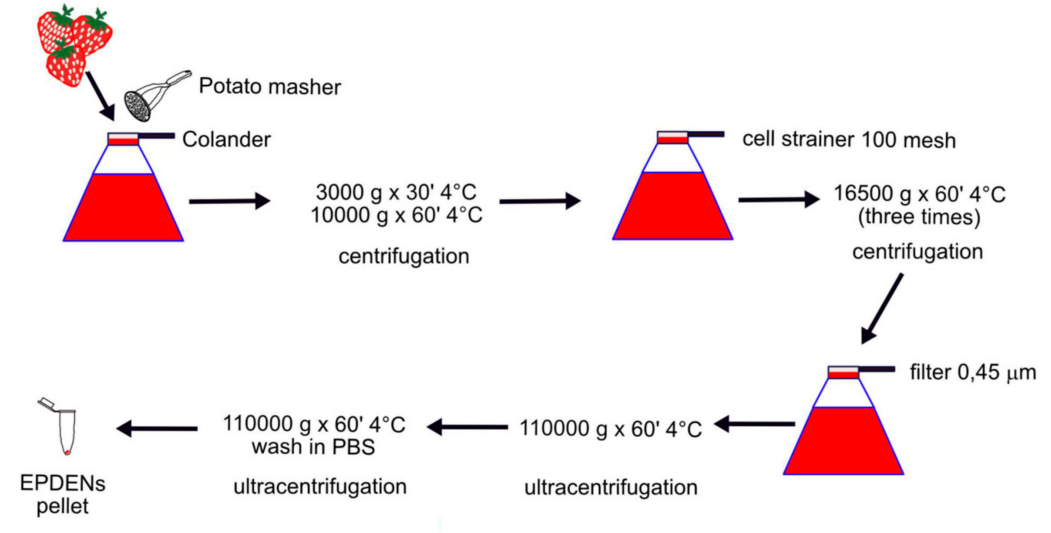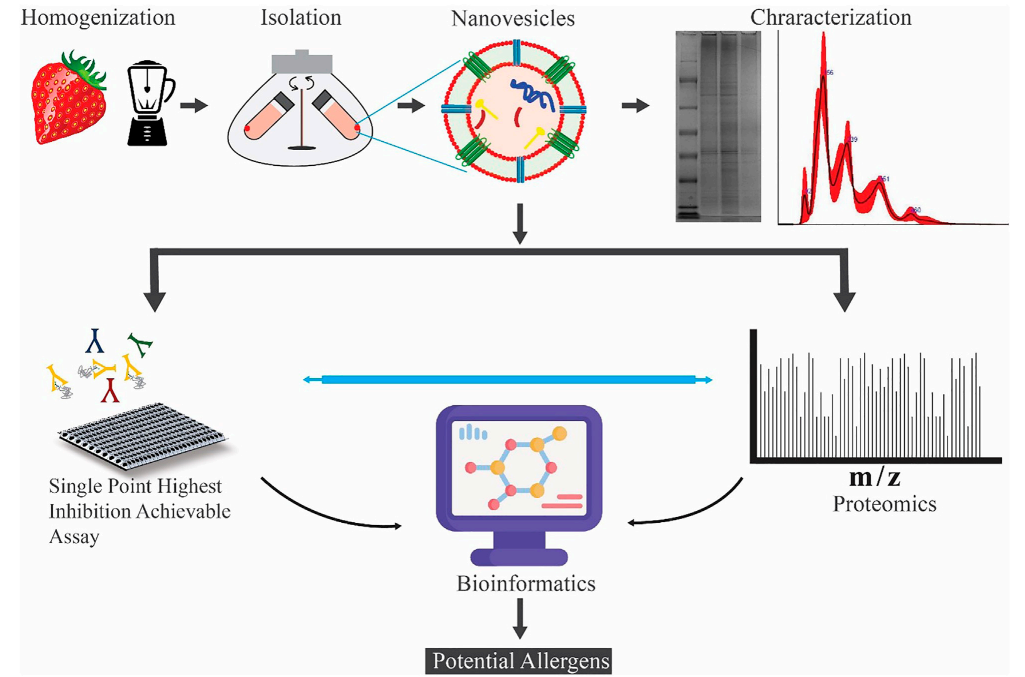Strawberry-derived Exosome Research and Application
Introduction Our Services Workflow Platform Advantages Deliverables Client Feedback FAQ
Introduction to Strawberry-Derived Exosomes: A Novel Frontier in Plant Biology
Strawberries are more than just a delicious fruit; they harbor a complex mixture of nutritive and non-nutritive bioactive compounds that vary across species. Among these, strawberry-derived exosomes have emerged as a promising subject of scientific inquiry due to their unique composition and potential applications in various biological fields. At Creative Biolabs, we are dedicated to advancing foundational research in this innovative area by offering specialized services focused on the isolation, characterization, and exploration of strawberry exosomes.
Plant-derived exosomes are small, nanosized vesicles naturally secreted by cells that mediate intercellular communication. Strawberry exosomes, in particular, carry an array of bioactive molecules such as small RNAs, proteins, and lipids, which can influence biological processes. Their capacity to encapsulate and transport these molecules makes them a valuable resource for researchers investigating plant physiology, molecular signaling, and potential biotechnological applications.
 Fig.1 A workflow for isolating strawberry-derived exosomes.1
Fig.1 A workflow for isolating strawberry-derived exosomes.1
Tailored Research Solutions from Creative Biolabs: What We Offer
Creative Biolabs stands at the forefront of plant exosome research, combining extensive expertise with cutting-edge technology to provide comprehensive pilot services centered on strawberry-derived exosomes. We assist academic labs, biotech companies, and other research institutions by offering:
-
Isolation and Purification: Utilizing optimized protocols including differential centrifugation and ultracentrifugation specifically adapted to strawberry tissues, we ensure high yield and purity of exosome preparations.
-
Characterization and Profiling: Employing advanced microscopy (TEM, fluorescence) and molecular assays, we analyze exosome morphology, size distribution, molecular cargo (RNAs, proteins), and bioactive components.
-
Functional Studies: Investigating cellular uptake, bioactivity (e.g., antioxidant properties), and molecular interactions of strawberry exosomes in relevant in vitro models.
-
Custom Experimental Design: Collaborating with clients to tailor projects according to research goals, including comparative studies, biomarker identification, and mechanistic exploration.
Our team at Creative Biolabs prioritizes scientific rigor and reproducibility to deliver robust data that empowers researchers to make confident conclusions and push the boundaries of plant exosome biology.
From Strawberry to Exosome: The Research Workflow
Our process for isolating and studying strawberry-derived exosomes involves several key stages designed to maintain the integrity and functionality of these vesicles:
-
Sample Preparation: Fresh strawberries undergo thorough washing and removal of calyxes before being mechanically crushed or juiced to release intracellular content.
-
Preliminary Filtration and Centrifugation: Initial centrifugation steps eliminate large debris and cellular residues, followed by sequential filtration to clarify the supernatant.
-
Ultracentrifugation Cycles: Multiple rounds of ultracentrifugation concentrate the exosome fraction, yielding a pellet enriched with strawberry-derived vesicles.
-
Resuspension and Storage: Isolated exosomes are resuspended in sterile phosphate-buffered saline (PBS) and stored at -80°C to preserve stability for downstream applications.
This workflow reflects our commitment at Creative Biolabs to meticulous protocol optimization, ensuring that exosomes retain their native biochemical properties for reliable study.
 Fig.2 Schematic diagram of investigating potential allergenic proteins in strawberry-derived vesicles.2
Fig.2 Schematic diagram of investigating potential allergenic proteins in strawberry-derived vesicles.2
Platform and Technologies Behind Creative Biolabs' Excellence
Creative Biolabs' research platform integrates state-of-the-art instrumentation and innovative methodologies:
-
High-Resolution Transmission Electron Microscopy (TEM): Visualizes exosome morphology, confirming their characteristic size and shape consistent with established vesicle standards.
-
Fluorescence Labeling and Imaging: Enables tracking of exosome uptake by target cells and assessment of biodistribution in vitro.
-
Molecular Profiling Tools: Including RNA sequencing and proteomics to characterize cargo composition, identify small RNAs such as miR166g enriched in strawberry exosomes, and detect potential allergenic proteins.
-
Bioactivity Assays: Evaluate the impact of exosomes on cellular oxidative stress, survival, and signaling pathways using models like H2O2-induced oxidative stress in cultured cells.
This integrated approach allows Creative Biolabs to provide comprehensive insight into the biological roles and potential utilities of strawberry exosomes.
Advantages of Partnering with Creative Biolabs
When selecting a research partner in the emerging field of plant-derived exosomes, Creative Biolabs offers several key benefits:
-
Specialized Expertise: Deep knowledge in plant exosome biology and hands-on experience with strawberry vesicles sets us apart.
-
Customized Services: Flexibility to design projects around client needs, from pilot studies to extensive molecular characterization.
-
Reliability and Reproducibility: Strict adherence to validated protocols ensures consistent results you can trust.
-
Collaborative Approach: Open communication and scientific consultation to support your research goals effectively.
-
Comprehensive Data Reporting: Detailed reports including imagery, molecular profiles, and functional data support your publications and presentations.
These advantages make Creative Biolabs an ideal partner for researchers aiming to explore strawberry exosomes with confidence.
What You Receive: Deliverables from Creative Biolabs
Our clients receive a full suite of deliverables to support their research objectives, including:
-
Purified strawberry exosome samples with quality control data
-
Detailed characterization reports featuring TEM images, size distribution, and molecular cargo profiles
-
Functional assay results highlighting bioactivity, such as antioxidant effects and cellular uptake
-
Customized experimental data tailored to project specifications
-
Ongoing scientific support and data interpretation assistance
Creative Biolabs is committed to providing actionable and transparent results that accelerate your discoveries in plant exosome science.
What Researchers Say: Feedback from Our Scientific Community
"Partnering with Creative Biolabs has significantly advanced our understanding of strawberry exosomes. Their isolation methods and detailed characterization gave us confidence in the quality of samples for our molecular signaling studies."
– Dr. EleXXXX
"The ability of Creative Biolabs to tailor experimental designs and provide comprehensive data reports helped us publish findings on bioactive molecules within strawberry vesicles. Their expertise is invaluable."
– Prof. JamXXXX
Such feedback reinforces Creative Biolabs' reputation as a trusted leader in plant-derived exosome research.
At Creative Biolabs, we are passionate about supporting the scientific community in unlocking the mysteries and potential of plant-derived exosomes. With a focus on strawberry exosomes, our research services provide a reliable foundation for exploring these nanoscale vesicles and their bioactive cargo. Whether you are conducting fundamental biology studies or biotechnological explorations, Creative Biolabs offers the expertise, technology, and collaboration necessary to elevate your research. Contact Creative Biolabs today to discuss your project needs and discover how we can help you harness the power of strawberry-derived exosomes for groundbreaking scientific progress.
Common Inquiries from Our Clients
Q: What makes strawberry-derived exosomes unique compared to other plant exosomes?
A: Strawberries contain distinctive bioactive compounds like anthocyanins and vitamin C, which are carried within their exosomes, potentially influencing antioxidant activity and intercellular communication in unique ways.
Q: Can Creative Biolabs support studies beyond basic isolation, such as functional assessments?
A: Absolutely. Creative Biolabs provides a range of functional assays, including cellular uptake, toxicity testing, and oxidative stress mitigation, to help elucidate the biological roles of exosomes.
Q: Are there any considerations regarding allergenic proteins in strawberry exosomes?
A: Our proteomic analyses identify proteins that could pose allergenic risks. Creative Biolabs advises researchers to evaluate such findings carefully when considering downstream applications.
Q: How do you ensure the purity and reproducibility of exosome preparations?
A: Through optimized centrifugation, filtration, and rigorous quality control, Creative Biolabs maintains consistent isolation standards to produce pure and reproducible exosome samples.
Q: What storage conditions do you recommend for strawberry exosomes?
A: We recommend resuspending exosomes in sterile PBS and storing them at -80°C to preserve integrity over time.
References
-
Perut, Francesca, et al. "Strawberry-derived exosome-like nanoparticles prevent oxidative stress in human mesenchymal stromal cells." Biomolecules 11.1 (2021): 87. Distributed under Open Access license CC BY 4.0. The image was modified by extracting and using only Part A of the original image and revising the title.
-
Stanly, Christopher, et al. "Crosstalk between the immune system and plant-derived nanovesicles: a study of allergen transporting." Frontiers in Bioengineering and Biotechnology 9 (2021): 760730. Distributed under Open Access license CC BY 4.0.The image was modified by revising the title.
For Research Use Only. Cannot be used by patients.
Related Services:

 Fig.1 A workflow for isolating strawberry-derived exosomes.1
Fig.1 A workflow for isolating strawberry-derived exosomes.1
 Fig.2 Schematic diagram of investigating potential allergenic proteins in strawberry-derived vesicles.2
Fig.2 Schematic diagram of investigating potential allergenic proteins in strawberry-derived vesicles.2









